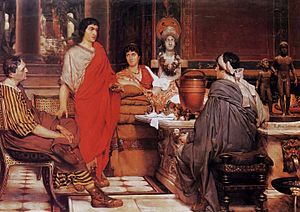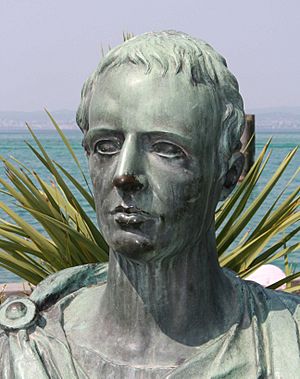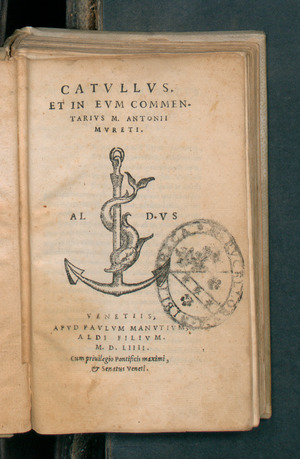Catullus facts for kids
Gaius Valerius Catullus (born around 84 BCE, died around 54 BCE), often called simply Catullus, was a famous Latin poet from the late Roman Republic. He wrote in a new style of poetry, focusing on his own life and feelings instead of stories about ancient heroes. His poems are still read today and inspire many artists.
Catullus's poems were very popular with other poets of his time, and they greatly influenced famous writers like Ovid and Virgil. After his works were rediscovered in the Late Middle Ages, poets like Petrarch also admired him. Today, Catullus's poems are often used to teach Latin in schools.
Catullus's writing style is very personal, funny, and full of emotion. He often uses hyperbole (exaggeration), anaphora (repeating words), alliteration (repeating sounds), and diminutives (words that mean "small" or "dear"). In 25 of his poems, he writes about his love for a woman he calls "Lesbia". Many people believe Lesbia was actually a Roman noblewoman named Clodia Metelli. One of his most famous poems is his 5th poem, known for its strong feelings and its opening line: "Vivamus, mea Lesbia, atque amemus" ("Let us live, my Lesbia, and let us love").
Contents
Life of Catullus
Gaius Valerius Catullus was born into an important family in Verona, a city in what was then called Cisalpine Gaul. His family was well-known, and Catullus's father even hosted Julius Caesar when Caesar was a powerful leader in the Gallic provinces. In one of his poems, Catullus describes how happy he was to return to his family's home in Sirmio, a town on Lake Garda near Verona. He also owned a home near the resort town of Tibur (now Tivoli).
Catullus likely spent most of his young adult years in Rome. There, he became friends with other poets like Licinius Calvus and Helvius Cinna. He also knew Cornelius Nepos, a biographer to whom Catullus dedicated a small book of poems. Famous people like Cicero, Caesar, and Pompey also appear in his poetry. It's said that even Julius Caesar, though sometimes criticized in Catullus's poems, didn't hold a grudge. When Catullus apologized, Caesar invited him to dinner that very day!

It was probably in Rome that Catullus fell deeply in love with the woman he called "Lesbia" in his poems. She is usually thought to be Clodia Metelli, a sophisticated woman from a noble Roman family. She was the sister of the famous Publius Clodius Pulcher and married to a Roman leader named Quintus Caecilius Metellus Celer. In his poems, Catullus describes the different stages of their relationship: the first joyful moments, then doubts, separation, and his painful feelings of loss. His strong feelings for her were constant, even though she didn't seem to want a serious, lasting relationship. Catullus's poems about their love show deep feelings and understanding of human emotions.
From summer 57 BCE to summer 56 BCE, Catullus worked in Bithynia, a Roman province in what is now Turkey. While he was there, he visited the Troad region to perform a ceremony at his brother's tomb. This sad event is described in one of his most touching poems.

We don't have any old biographies about Catullus, so we learn about his life from small mentions in other ancient writings and from his own poems. This is why we aren't completely sure when he was born or when he died. Some ancient writers said he died at age 30, born in 87 BCE. However, his poems mention events from 55 and 54 BCE. Because of this, many scholars believe he lived from 84 BCE to 54 BCE, suggesting his last poems were written around the time he passed away.
Catullus's Poetry
Catullus's poems have been collected into an anthology (a collection) of 116 poems, called carmina. These poems can be grouped into three types based on their style:
- Sixty short poems with different rhythms, called polymetra.
- Eight longer poems.
- Forty-eight epigrams, which are short, witty poems.
Scholars are not sure if Catullus himself arranged the poems in this order. The longer poems are different from the short ones and the epigrams. They are not only longer but also cover different topics. These include seven hymns (songs of praise) and one mini-epic poem, which was a very popular style for the "new poets" of his time.
All of Catullus's poems describe the lives of him and his friends. Even though Catullus had a temporary job in Bithynia, they mostly stayed away from politics. They were mainly interested in poetry and love. Catullus especially valued venustas, which means charm or grace, in the people he knew. He explored this idea in many of his poems. The traditional Roman idea of virtus (meaning virtue or courage, often shown through a political or military career) was not as important to them.
However, Catullus didn't completely reject old ideas. Instead, he tried to give them new meaning in personal relationships. For example, he used the word fides, which traditionally meant loyalty to political allies, to describe unconditional faithfulness in love. So, even though his lifestyle might seem carefree, Catullus and his friends had high standards for themselves and their relationships.
Influences on Catullus's Poetry
Catullus's poetry was inspired by the new and creative poetry of the Hellenistic Age. He was especially influenced by Callimachus and the Alexandrian school of poets. These poets created a new style that moved away from the traditional epic poetry of Homer, which told stories of heroes. Cicero called these new poets neoteroi (meaning "moderns" in Greek) or poetae novi ("new poets" in Latin). They wanted to write in a fresh, contemporary way, different from the old heroic poems.
Catullus and Callimachus didn't focus on the great deeds of ancient heroes and gods. Instead, they wrote about smaller, personal topics. Even though these poems sometimes seem simple and about everyday things, they are very skillfully written. Catullus described his own work as expolitum, meaning "polished," to show how carefully and artistically he chose his words.
Catullus also admired Sappho, a female poet from the 7th century BCE. Catullus's Catullus 51 partly translates and partly imitates one of Sappho's poems. Some people think that his poems 61 and 62, which are epithalamia (wedding poems), might have been inspired by Sappho's lost works. Catullus used a special poetic rhythm called the Sapphic stanza in two of his poems, 11 and 51, which Sappho was famous for.
Like many writers of his time, Catullus was greatly influenced by stories from Greek and Roman myths. His longer poems, such as 63, 64, 65, 66, and 68, refer to myths in different ways. Some of the stories he mentions include the wedding of Peleus and Thetis, the journey of the Argonauts, Theseus and the Minotaur, Ariadne being left behind, and Tereus and Procne.
Catullus's Style
Catullus wrote using many different poetic rhythms, including hendecasyllabic verse and elegiac couplets, which were common in love poetry. A large part of his poetry shows strong and sometimes wild emotions, especially when he writes about Lesbia (for example, in poems 5 and 7). His love poems are very emotional and passionate, and people can still relate to them today. Catullus describes Lesbia as having many admirers and often not showing him much affection. He also shows a great sense of humor, like in Catullus 13.
Musical Settings of Catullus's Poems
Many composers have been inspired by Catullus's poems and set them to music:
- Catullus Dreams (2011) by David Glaser is a collection of songs using Catullus's texts.
- Catulli Carmina is a musical piece by Carl Orff that uses Catullus's poems.
- "Carmina Catulli" is a song collection arranged from 17 of Catullus's poems by American composer Michael Linton.
- Dutch composer Bertha Tideman-Wijers used Catullus's words for her piece Variations on Valerius "Where that one already turns or turns."
- Catullus 5, the love poem "Vivamus mea Lesbia atque amemus," has been set to music by several composers, including Alfonso Ferrabosco the younger and Thomas Campion.
- The Hungarian-born British composer Matyas Seiber set poem 31, "Sirmio," for a choir in 1957.
- Finnish jazz singer Reine Rimón has recorded Catullus's poems set to jazz tunes.
- American composer Ned Rorem set Catullus 101 to music for voice and piano.
- Icelandic composer Jóhann Jóhannsson set Catullus 85 to music. This song, called "Odi Et Amo," is on his album Englabörn.
Cultural Depictions of Catullus
Catullus and his stories have appeared in many forms of art and literature:
- The 1888 play Lesbia by Richard Davey tells the story of Catullus and Lesbia's relationship, based on his poems.
- Catullus was the main character in the historical novel Farewell, Catullus (1953) by Pierson Dixon, which showed the challenges of Roman society.
- W. G. Hardy's novel The City of Libertines (1957) is a fictional story about Catullus and a love affair during the time of Julius Caesar.
- In the 1963 film Cleopatra, a poem by Catullus is recited to Cleopatra when Julius Caesar visits her. They then discuss Catullus and Caesar recites more of his poems.
- The American poet Louis Zukofsky created unique translations of Catullus's poems in 1969, focusing on making the English sound like the original Latin. These translations have influenced many modern poets.
- Catullus is the main character in Tom Holland's 1995 novel Attis.
- Catullus also appears in Steven Saylor's novel The Venus Throw as the former lover of Clodia, whom he calls Lesbia.
See also
 In Spanish: Catulo para niños
In Spanish: Catulo para niños



